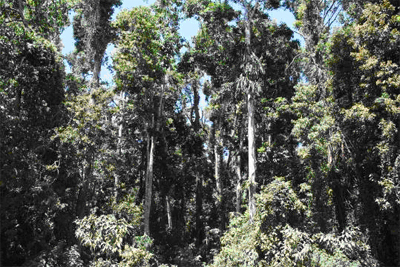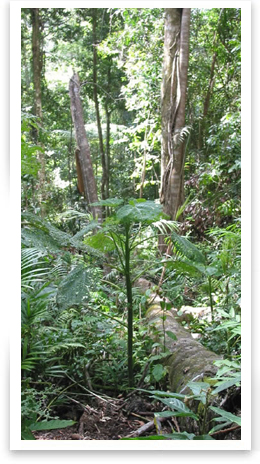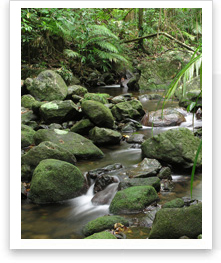Fundamentals of rainforest ecology
Fundamental to sound ecosystem management is comprehensive ecological knowledge and in this next section we will examine some basic ecological properties of tropical rainforests.
![]()
Based on your experience of rainforests (being in them, visual representations of them etc) how would you define a rainforest as compared with other ecosystems?
There are common misconceptions associated with tropical forests. Colonial powers of the previous centuries saw tropical rainforest regions as having almost unlimited bountifulness, with their luxuriant growth and high diversity and were viewed as ecosystems available for agricultural exploitation. Over the last 100 years or more, this has proved to be a false hope, with tropical soils often (but not exclusively) being poor in nutrient status and not suited to agricultural activity. More recent paradigms have viewed rainforests as'fragile' environments, with any form of human activity seen as undesirable.
Rainforests have been simply be defined as tree-dominated, water-loving ecosystems that occur in the non-seasonal tropics (Hill and Hill, 2001), with a vegetation cover >80%. This is a somewhat limited definition, as we will see when we examine Australian rainforests, but this provides some idea of their basic properties.
As rainforests tend to occur in high rainfall zones, water availability is not a limiting factor to growth and productivity is typically high. Competition for light and growing space are key determinants of forest structure and rainforests feature complex, multi-layered canopies. On high rainfall, lowland environments with little seasonality of climate and good soils, structural complexity tends to be high.
These complex forest types are usually associated with a high diversity of flora and fauna. Tall emergent trees tower above the bulk canopy (Figure 1), individuals that have 'escaped' the intense competition for light and growing space. Below the emergents is the upper canopy, which forms the bulk of the canopy and comprises a huge variety of mature tree species. Below this is a mid-canopy layer of suppressed, light demanding species and/or shade-tolerant trees, waiting for an opening (or canopy gap) in the upper canopy that they can exploit (Figure 3). Below these layers is often a rich, high density understorey of suppressed tree saplings, shrubs and herbs. Wet tropical rainforest also support a luxuriant epiphytes and lianas, with a huge variety of species and life-forms.
The multi-layered structural complexity of rainforest provides a wide variety of niches that supports a high diversity of fauna, especially mammals and birds, with different groups of animal occupying different canopy layers. There are many millions of invertebrate species found in rainforests and the total number of species found is not precisely known. On marginal sites of low and/or seasonal rainfall or inundated or poorly drained soils, the structural complexity is simpler, with often only 1 or two canopy layers evident. The upper canopy is often dominated by one or two tree species.

Figure 3 Canopy gap revealing rainforest canopy
layers
(Photo: I. Dixon).
Rainforests are primarily distributed as a function of prevailing and past climatic conditions, with rainfall amount and seasonality a key driver. Secondary drivers of distribution include soil type and topography, temperature, disturbance and fire regime. These factors determine structural complexity and formation type, with the most structurally complex and biologically diverse forest types occurring on good soils in high rainfall zones. Highly seasonal tropical environments, such as those found in the Northern Territory, result in structurally simple and low diversity rainforest types.
![]()
Activity 3.1
Rainforest ecology
To examine management issues associated with tropical rainforest, we need to have an understanding of their ecological properties. For an introduction to rainforest ecology, we will use a chapter from Osborne (2000) 'Tropical Rain Forests And Biodiversity'. This chapter provides basic information on;
- Rainforest biogeography
- Structural features
- Life forms and rainforest phenology
- Plant-animal interactions
- Rainforests and biodiversity
- Successional process and gap phase dynamics
- Low diversity rainforest types
- Habitat fragmentation and conservation
Read this chapter as an introduction. Because it is not possible to cover all of these topics in detail, we will focus on key aspects in more detail below.
![]()
Activity 3.2
Rainforest diversity
One dominant feature of rainforest ecosystems is their high biodiversity, with some lowland rainforest sites of the Amazon basin and Borneo featuring 500 species of tree per hectare and an unknown numbers of invertebrate species.
Why are these ecosystems so diverse? Provide a summary of current understanding of why these ecosystems are so diverse.
Focus on Section 8.11 of Osborne (2000). This section provides basic theoretical ideas associated with biodiversity.
Now read the review paper of Hill and Hill (2001), in particular Section I-III. This paper provides a more detailed examination of current and previous theories relating to biodiversity and poses the simple question: Why are tropical rainforests so species rich?
![]()
Hill and Hill (2001) suggest there are 12 theories currently proposed that all contribute to explaining high rainforest diversity. However, some have more validity than others, with no single theory being applicable for all rainforest types.
Two groupings of theories are evident in the literature., One organises theories that operate over a range of spatial and temporal scales. The second set focuses on the following factors as driving high levels of diversity: genetic differentiation, the environmental stability of the tropics, habitat diversification and biotic interactions between plants and animals.
Osborne (2000) further summaries these ideas into 7 groupings as summarised on p 263.
Next topic - Rainforest diversity, disturbance and gap-phase dynamics
Topics in this module



